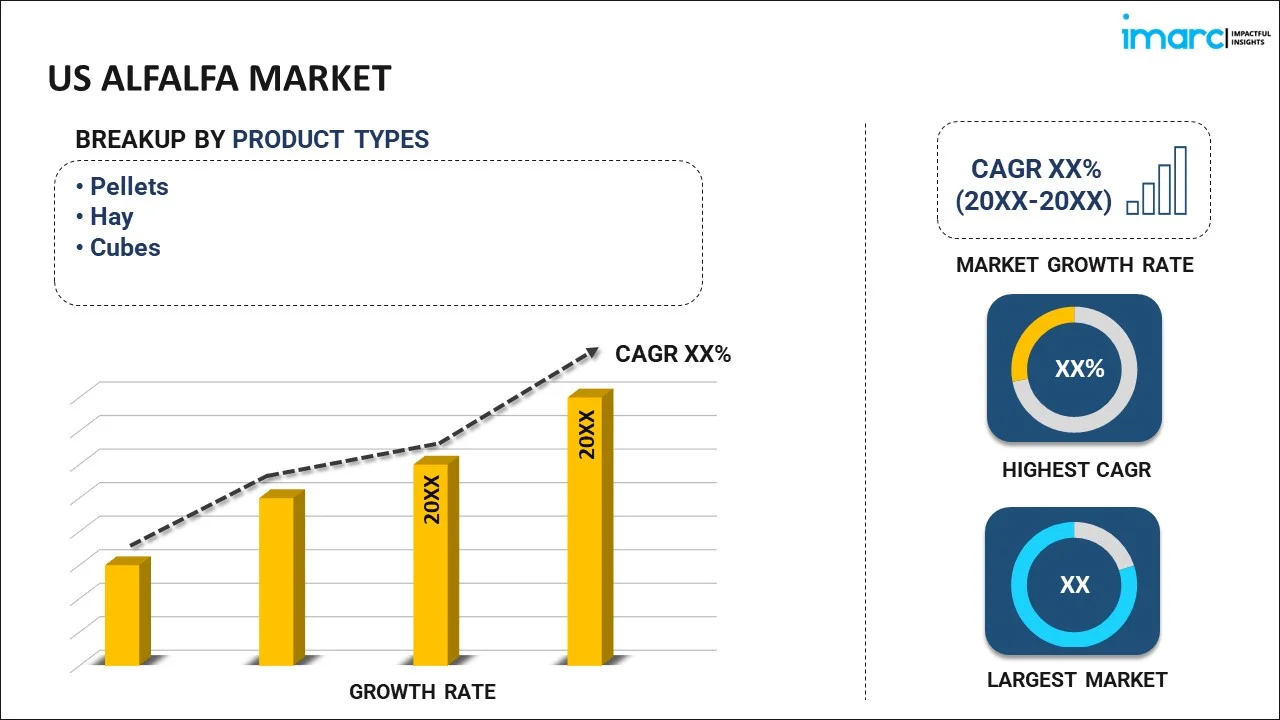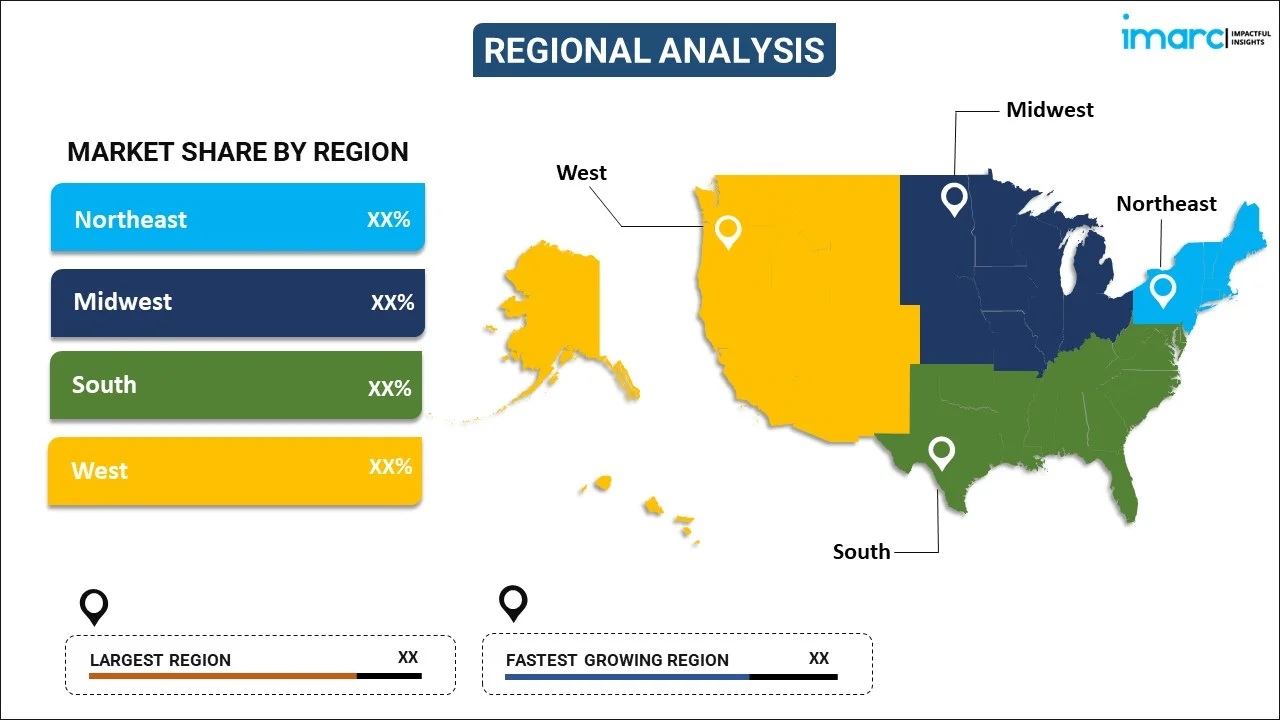IMARC made the whole process easy. Everyone I spoke with via email was polite, easy to deal with, kept their promises regarding delivery timelines and were solutions focused. From my first contact, I was grateful for the professionalism shown by the whole IMARC team. I recommend IMARC to all that need timely, affordable information and advice. My experience with IMARC was excellent and I can not fault it.
Read More
US Alfalfa Market Report by Product Type (Pellets, Hay, Cubes), Animal Type (Cattle, Horse, and Others), and Region 2024-2032
Market Overview:
US alfalfa market size reached US$ 7.8 Billion in 2023. Looking forward, IMARC Group expects the market to reach US$ 13.3 Billion by 2032, exhibiting a growth rate (CAGR) of 5.80% during 2024-2032. The shifting consumer preferences towards products derived from animals raised on high-quality forage, along with the continuous innovations by leading players in the livestock industry, are primarily driving the market growth across the country.
|
Report Attribute
|
Key Statistics
|
|---|---|
|
Base Year
|
2023
|
|
Forecast Years
|
2024-2032
|
|
Historical Years
|
2018-2023
|
|
Market Size in 2023
|
US$ 7.8 Billion |
|
Market Forecast in 2032
|
US$ 13.3 Billion |
| Market Growth Rate 2024-2032 | 5.80% |
Alfalfa is a versatile and nutrient-rich legume that has been cultivated for centuries for both human and animal consumption. Renowned for its adaptability to various climates and soil conditions, alfalfa is primarily grown as a forage crop for livestock, providing an excellent source of protein and essential nutrients. Its deep-rooted system enables it to absorb a wide range of minerals from the soil, enhancing its nutritional profile. Beyond its role in animal husbandry, alfalfa is also a valuable human food source. Packed with vitamins, minerals, and antioxidants, it is extensively utilized in the preparation of salads, sandwiches, health drinks, etc. Additionally, alfalfa is recognized for its potential health benefits, as it aids in digestion, reducing cholesterol, supporting overall well-being, etc. As a cover crop, it further contributes to soil fertility by fixing nitrogen and preventing erosion.
US Alfalfa Market Trends:
The US alfalfa market is undergoing dynamic shifts driven by several key factors and trends. The increasing demand for high-quality forage in the livestock industry is primarily catalyzing the market growth across the country. Additionally, the rising awareness among individuals towards the health benefits associated with alfalfa consumption is fueling its popularity, thereby positively influencing the market growth. Besides this, climate change and its impact on agriculture are also significant trends shaping the US alfalfa market. Moreover, farmers are exploring alfalfa varieties that exhibit resilience to changing climate conditions, ensuring stable yields and quality. Furthermore, technological advancements are playing a pivotal role in alfalfa cultivation. Apart from this, precision farming techniques, such as satellite imagery and data analytics, are optimizing resource utilization and improving overall crop management. These innovations contribute to increased efficiency and sustainability in the alfalfa supply chain. Additionally, with the growing demand for alfalfa in international markets, exporters are exploring new opportunities, thereby fostering economic growth in the domestic agricultural sector. As such, changing dietary preferences, climate considerations, technological innovations, and evolving trade dynamics are acting as significant growth-inducing factors. Stakeholders in the industry are strategically adapting to these trends, which is expected to fuel the US alfalfa market over the forecasted period.
US Alfalfa Market Segmentation:
IMARC Group provides an analysis of the key trends in each segment of the market, along with forecasts at the country level for 2024-2032. Our report has categorized the market based on product type and animal type.
Product Type Insights:

- Pellets
- Hay
- Cubes
The report has provided a detailed breakup and analysis of the market based on the product type. This includes pellets, hay, and cubes.
Animal Type Insights:
- Cattle
- Horse
- Others
A detailed breakup and analysis of the market based on the animal type have also been provided in the report. This includes cattle, horse, and others.
Regional Insights:

- Northeast
- Midwest
- South
- West
The report has also provided a comprehensive analysis of all the major regional markets, which include Northeast, Midwest, South, and West.
Competitive Landscape:
The market research report has also provided a comprehensive analysis of the competitive landscape in the market. Competitive analysis such as market structure, key player positioning, top winning strategies, competitive dashboard, and company evaluation quadrant has been covered in the report. Also, detailed profiles of all major companies have been provided.
US Alfalfa Market Report Coverage:
| Report Features | Details |
|---|---|
| Base Year of the Analysis | 2023 |
| Historical Period | 2018-2023 |
| Forecast Period | 2024-2032 |
| Units | US$ Billion |
| Scope of the Report | Exploration of Historical Trends and Market Outlook, Industry Catalysts and Challenges, Segment-Wise Historical and Future Market Assessment:
|
| Product Types Covered | Pellets, Hay, Cubes |
| Animal Types Covered | Cattle, Horse, Others |
| Regions Covered | Northeast, Midwest, South, West |
| Customization Scope | 10% Free Customization |
| Post-Sale Analyst Support | 10-12 Weeks |
| Delivery Format | PDF and Excel through Email (We can also provide the editable version of the report in PPT/Word format on special request) |
Key Questions Answered in This Report:
- How has the US alfalfa market performed so far and how will it perform in the coming years?
- What has been the impact of COVID-19 on the US alfalfa market?
- What is the breakup of the US alfalfa market on the basis of product type?
- What is the breakup of the US alfalfa market on the basis of animal type?
- What are the various stages in the value chain of the US alfalfa market?
- What are the key driving factors and challenges in the US alfalfa?
- What is the structure of the US alfalfa market and who are the key players?
- What is the degree of competition in the US alfalfa market?
Key Benefits for Stakeholders:
- IMARC’s industry report offers a comprehensive quantitative analysis of various market segments, historical and current market trends, market forecasts, and dynamics of the US alfalfa market from 2018-2032.
- The research report provides the latest information on the market drivers, challenges, and opportunities in the US alfalfa market.
- Porter's five forces analysis assist stakeholders in assessing the impact of new entrants, competitive rivalry, supplier power, buyer power, and the threat of substitution. It helps stakeholders to analyze the level of competition within the US alfalfa industry and its attractiveness.
- Competitive landscape allows stakeholders to understand their competitive environment and provides an insight into the current positions of key players in the market.
Need more help?
- Speak to our experienced analysts for insights on the current market scenarios.
- Include additional segments and countries to customize the report as per your requirement.
- Gain an unparalleled competitive advantage in your domain by understanding how to utilize the report and positively impacting your operations and revenue.
- For further assistance, please connect with our analysts.

Benefits of Customization
Personalize this research
Triangulate with your data
Get data as per your format and definition
Gain a deeper dive into a specific application, geography, customer, or competitor
Any level of personalization
Get in Touch With Us
UNITED STATES
Phone: +1-631-791-1145
INDIA
Phone: +91-120-433-0800
UNITED KINGDOM
Phone: +44-753-714-6104
Email: sales@imarcgroup.com
 Inquire Before Buying
Inquire Before Buying Speak to an Analyst
Speak to an Analyst  Request Brochure
Request Brochure  Request Customization
Request Customization



.webp)




.webp)












